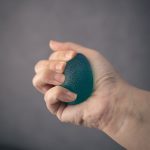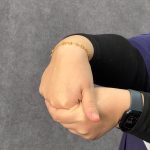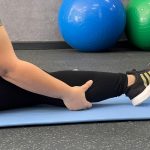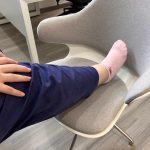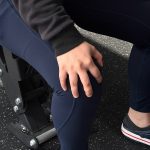
Health Blog | 3 MIN READ
Neck Pain
Dr. Katherine Valdez
Overview
Neck pain can affect anyone at any age, but it is most common in adults. According to your posture, work environment, sleeping position, or just a strain, neck pain can feel sore, weak, and restrict your movement when rotating from left to right.
Understanding Your Neck
Your neck is made of small bones known as “vertebrae” that extend from the skull to upper-back. The muscles, bones and ligaments of your neck support your skull and its motion. Any form of inflammation, injury can cause pain and stiffness.

The 7 Types of Neck Pain
Neck pain is common, however, if you were to ask a group of people with neck pain about their symptoms, you would receive a lot of vastly different descriptions.
Muscle Pain
Muscle straining, spraining and tearing are one of the most common ways neck pain is revoked. When the muscles are overworked, micro-tears can form in one of the layers of the muscular tissue, which not only causes pain but weakens it. If the strains go untreated for long periods of time, the neck and surrounding muscles like the shoulder will develop stubborn knots known as “trigger points” that are tender and painful to the touch causing more pain and soreness.
Muscle Spasm
A sudden, impulsive and painful contraction of muscle known as a muscle spasm which is usually felt in the back of the head till the upper neck. Patients who experience spasms may feel pain, tightness and inability to move in more than one direction. The direct cause has not yet been clear, however it can be caused by an injury, nerve problems and even emotional stress.
Headache
Tension or spasms in the neck may result in headaches which are described to feel like a dull or aching feeling, sided with neck stiffness and tenderness. Oftenly, the more the patient moves, the more the pain increases so they are left to rest until treated.
Nerve Pain
Nerve pain is commonly referred to as “pinched nerve”. Each vertebra has one or more nerves that branch off the spinal cord as a result of the nerve being compressed or irritated.
Referred Pain
Referred pain is pain on a specific part of the body triggered by an unrelated site. For instance, neck pain can be a result of heart, esophagus or other unrelated organs. It is crucial for patients to diagnose the underlying root cause of their neck pain as it may be more serious than they think
Facet Joint Pain
The neck has two facet joints located in the back of the vertebrae, these joints are responsible for stability, movement, turning and nodding of the neck. Any injury or degeneration to these joints can cause a patient to feel a sharp, deep, aching that worsens upon touch or after long periods of inactivity (e.g after waking up). This pain can grow unto your shoulders, upper back, essentially harming your entire upper-back.
Bone Pain
Pain and tenderness in the bone itself (cervical vertebrae) is not common, however occurs. It calls for immediate medical attention as it could be a sign of something more serious such as bone damage or weakness, which may destabilize the cervical spine (neck region) putting your spinal cord at risk.
Who gets neck pain?
Neck pain is found in many people as it is a direct result of harmful daily activities and accidents. It is commonly found in women more than men, and as you grow older, your risk of developing neck pain increases.
How Is It Diagnosed?
The physiotherapists will conduct a physical assessment where they feel the area, find the trigger points and find the root problem. The physio may move your neck to locate the pain and motion-related problems.
An imaging test, such as an MRI (magnetic resonance imaging) or an X-ray, may be recommended by your doctor.
Causes
■ Worry or stress. When one experiences high levels of anxiety, the body’s natural reaction is to tense up causing stiffness, tightness, tension and aching pain in your neck.
■Sleeping incorrectly. Putting your neck in an unnatural position for so long can cause ligament irritation (the tissue that connects your bones to other bones) and neck spasms.
■ Accidents and Injuries. The sudden forceful back and front movement of the neck which causes the injury “whiplash”.
■ Muscle Sprain and Strains. Overusing your neck muscles by incorrect posture by being hunched over on the phone, computer or book.
■ Worn Joints. Neck joints tend to wear as the other joints in the body, causing spinal discs in the neck to dehydrate, shrink and degenerate (Cervical Spondylosis).
Symptoms of Neck Pain
■ Pain and stiffness
■ Numbness or tingling
■ Clicking and grating noises
■ Dizziness
■ Muscle Spasms
Neck Pain Treatment
Physical Treatment
Physiotherapists, osteopaths and chiros are all trained to treat neck pain along with exercises.
Dry Needling For Neck Pain
Dry needling is a viable option for stimulating those triggering hypersensitive points proven to relieve pain and increase range of motion.
● Decreases Muscle Spasms And Associated Neck Pain ● Boosts Healing In Affected Area Via The Increased Blood Flow ● Better Joint Mobility ● Decreased Muscle Tightness
Dry Cupping For Neck Pain
Cups are generally placed in the upper back and the neck, whilst it is there, patients are encouraged to do a variety of range-of-motion movements. Another technique called “glide cupping” where oil is put in the area and the cup is glided to ease movement with low level vacuum on the cup..
● Decreases Numbness, Tightness And Pain ● Treats Muscle Weakness ● Improved Blood Circulation ● Increased Oxygenated And Total Hemoglobin Levels
Manual Therapy
Both techniques in manual therapy and assisted stretching have been used to relieve neck pain. Treatments such as cervical mobilization to move and manipulate the neck joints and muscles.
● Pain Reduction ● Improved Ability
Manipulation
A form of manual therapy to treat stiffness by adjusting joints in the neck. It is important you discuss with a professional your case and history to ensure manipulation is the right treatment for your case (e.g it is not recommended for conditions such as osteoarthritis).
TENS (transcutaneous electrical nerve stimulation)
Introducing electrical currents to the skin is a well-liked method of treating neck pain. Two Electrodes are placed on either side of your neck. The device sends electrical pulses through the surface of the skin, igniting your body’s natural painkillers. These pulses can also release endorphins and other substances that block pain signals in the brain
Acupuncture
When the needles are placed on the Jian Jing (halfway where your neck and arms begin). Fine needles are placed on different sites of the body to relieve neck pain, usually punctured not where the pain is initiated.
Traction
A cervical traction involves creating a space between the bones in your neck by lightly pulling it from the rest of your body to reduce compression. It works by stretching the spinal vertebrae and muscles to relieve pain and pressure
Ice/ Heat Therapy
Apply a cool compress after an injury or accident to reduce pain, inflammation and swelling. Placing a hot compress will allow the muscles to relax and boost blood circulation allowing the nutrients to move.
Prevention
■ Maintain a good posture. Make sure your neck is at eye level when reading, studying or scrolling through your phone.
■ Sleep in neutral positions. Your neck and head should be aligned with the rest of your body. To align your spine, sleep on your back with your feet elevated by a pillow.
■ Take frequent breaks. If you travel, drive, study or work for long periods of time, ensure you're allowing your neck to relax and stretch.
■ Avoid heavy bags and thin straps over your shoulder. The weight and pressure can strain your neck.
■ Quit smoking. It is a risk of developing neck pain.
People also ask
1. Progressively worsening after self or clinical remedies.
2. Pain radiates to your limbs.
3. Neck pain is coupled with a headache, numbness, tingling and weakness.
4. Neck pain along with a fever may signal something serious.
You can try to relieve it using cool compress, gentle massage and over the counter pain-killers.
To avoid it you can try light stretching or massaging, or changing your pillow and daily habits harmful to your neck.


